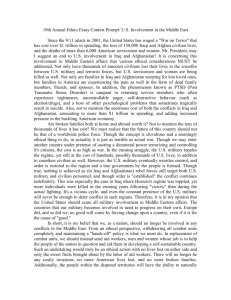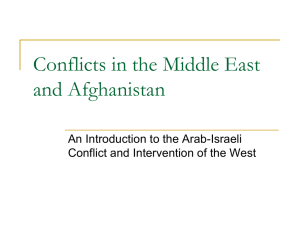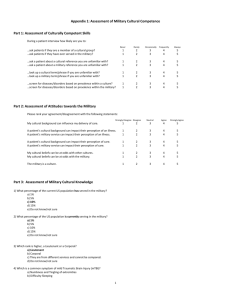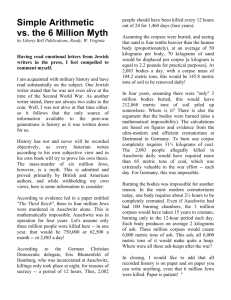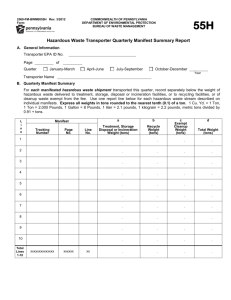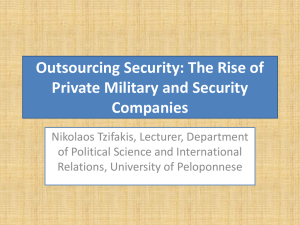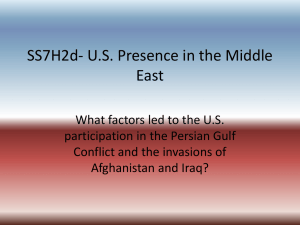War, Ecology & Intelligence
advertisement
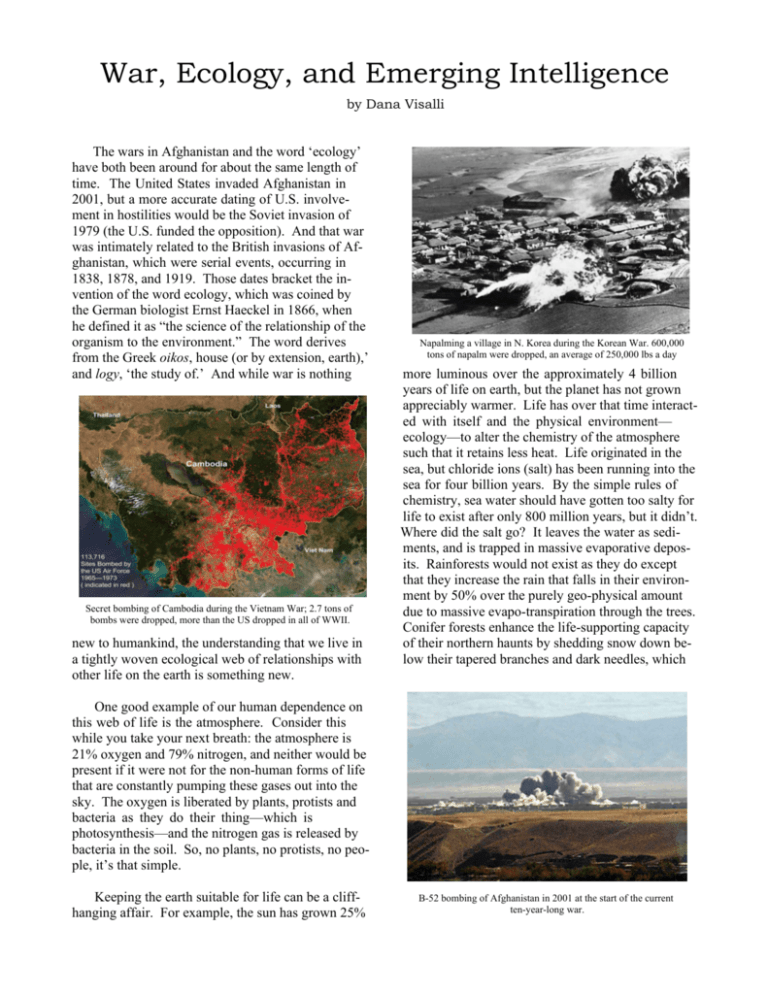
War, Ecology, and Emerging Intelligence by Dana Visalli The wars in Afghanistan and the word ‘ecology’ have both been around for about the same length of time. The United States invaded Afghanistan in 2001, but a more accurate dating of U.S. involvement in hostilities would be the Soviet invasion of 1979 (the U.S. funded the opposition). And that war was intimately related to the British invasions of Afghanistan, which were serial events, occurring in 1838, 1878, and 1919. Those dates bracket the invention of the word ecology, which was coined by the German biologist Ernst Haeckel in 1866, when he defined it as “the science of the relationship of the organism to the environment.” The word derives from the Greek oikos, house (or by extension, earth),’ and logy, ‘the study of.’ And while war is nothing Secret bombing of Cambodia during the Vietnam War; 2.7 tons of bombs were dropped, more than the US dropped in all of WWII. new to humankind, the understanding that we live in a tightly woven ecological web of relationships with other life on the earth is something new. Napalming a village in N. Korea during the Korean War. 600,000 tons of napalm were dropped, an average of 250,000 lbs a day more luminous over the approximately 4 billion years of life on earth, but the planet has not grown appreciably warmer. Life has over that time interacted with itself and the physical environment— ecology—to alter the chemistry of the atmosphere such that it retains less heat. Life originated in the sea, but chloride ions (salt) has been running into the sea for four billion years. By the simple rules of chemistry, sea water should have gotten too salty for life to exist after only 800 million years, but it didn’t. Where did the salt go? It leaves the water as sediments, and is trapped in massive evaporative deposits. Rainforests would not exist as they do except that they increase the rain that falls in their environment by 50% over the purely geo-physical amount due to massive evapo-transpiration through the trees. Conifer forests enhance the life-supporting capacity of their northern haunts by shedding snow down below their tapered branches and dark needles, which One good example of our human dependence on this web of life is the atmosphere. Consider this while you take your next breath: the atmosphere is 21% oxygen and 79% nitrogen, and neither would be present if it were not for the non-human forms of life that are constantly pumping these gases out into the sky. The oxygen is liberated by plants, protists and bacteria as they do their thing—which is photosynthesis—and the nitrogen gas is released by bacteria in the soil. So, no plants, no protists, no people, it’s that simple. Keeping the earth suitable for life can be a cliffhanging affair. For example, the sun has grown 25% B-52 bombing of Afghanistan in 2001 at the start of the current ten-year-long war. initiated 3000 years ago with the advent of iron tools, but it is population growth and recent wars that has nearly eradicated them; today only 1.5% of the land has any tree cover. When one visits Afghanistan today, one is impressed by the quantity of rocks—there is little vegetation left in the country. This process of ecological decay has continued through the ten years of the U.S. war in Afghanistan, which began with B-52 bombing raids over various parts of the country in 2001. We think of war as ‘politics by another name,’ a means of resolving disputes between people. But there is another side to war, and that is violence perpetuated on the earth itself. The United States dropped about two million tons of bombs in World War II. While these explosives were aimed at human targets, they all landed on and damaged the earth. Only five years after the end of that war, we dropped 600,000 tons of munitions on Korea, as well as another 600,000 tons of napalm. A year after the end of the Korean war (1953) we were militarily engaged in Vietnam, where over the course of twenty years we dropped seven million tons of bombs (considerably more than in WWII) and 400,000 tons of napalm, as well as spraying six million acres of tropical forest and cropland with teratogenic and carcinogenic defoliant (the spraying program, Operation Ranch Hand, had a motto: “Only you can prevent forests”). At the same time, as something of a sideshow, we also Areas of tropical forest sprayed with Agent Orange and other defoliants by the US during the Vietnam War. This was in addition to bombing. then absorb heat much more rapidly in the spring than a reflective snow cover would. As these examples illustrate, life moderates the physical environment to make it more favorable for life. This is why, in spite of some major natural disasters through history—like being hit by a massive asteroid 65 million years ago--life on earth has grown increasingly diverse and complex over time. This is also why Darwin ended his treatise on evolution, On The Origin of Species, in this way: “There is grandeur in this view of life…. from so simple a beginning endless forms most beautiful and most wonderful have been, and are being, evolved.” Humans all over the planet are currently reversing this ancient evolutionary process of increasing biological richness over time, and there is no better example of this fact than the situation in Afghanistan. When the first anatomically modern humans reached Afghanistan about 60,000 years ago, the landscape was very different than it is today. Archaeological studies reveal that, at least until 2000 BCE, the territory of today's Afghanistan was partially covered with cedar forests, which would have recycled precipitation through evapo-transpiration and formed water-retaining mulch and shade on the ground—making the environment more suitable for life. Forest loss was Map showing the areas of secret carpet bombing of Laos during the Vietnam War. 3 million tons of bombs were dropped. 2 and sky. So in a somewhat poetic but still scientific sense, the earth is our mother; we emerged from the planet’s evolutionary cauldron and to the earth we shall return. Why all the violence against the earth, the source of our lives? Male mammals have an inherent urge for power, and humans have an inherent fear of death. The genetically-induced emotions related to these passions may be the subconscious forces that are driving our dysfunctional and selfdestructive aggressive behavior. Intelligence—the word derives from Latin roots meaning ‘to choose between,’ and is defined as ‘the capacity to think rationally, perceive what is true, and respond successfully to new situations’— is something new on the planet. It was six million years in the making, in the sense that brain size has increased over that length of time from 400 cc (cubic centimeters) in our common ancestor with chimpanzees, to 1300 cc today. Like everything that exists in the biological world, intelligence is emergent; formerly it did not exist, now it does—at least by degrees. Because it is emergent, it appears progressively, a little at a time, like a salamander cautiously emerging from a mudhole. For example, the modern brain capacity of 1300 cc was reached 200,000 years ago, but there was no discernable change in human behavior until 40,000 years ago. At that point, human tool-making abilities began to rapidly improve, and both art and musical ability appear in the archeological record. A graphic indicating the bombing of Iraq during the Second Iraq War in 2003. Most of the country's social infrastructure not destroyed in the Gulf War was destroyed in this one 12 years later. bombed Cambodia (2.7 million tons of bombs, 1 million gallons of defoliant) and Laos (3 million tons of bombs, 1 million gallons of defoliant). These were wars not just against human enemies (mostly impoverished rice farmers) but against some of richest ecosystems on the planet, and against the life-sustaining capacity of the biosphere. War has become a way of life for the United States. Our country funded the civil wars in Central America in the 1970s and 1980s (Guatemala, El Salvador, Nicaragua), funded the mujahideen fighting against the Russians in the 1979-1989 war with Afghanistan, funded both sides in the 1980-1988 Iran-Iraq war, and then in 1990 went back to war ourselves, with Iraq, with Afghanistan in 2001, and then initiated a covert war with Pakistan in 2004. As Vietnam veteran Mike Hastie observed, “The United States is a non-stop killing machine.”2 This country also maintains a nuclear arsenal of 7000 hydrogen bombs, many times more than enough to destroy the majority of life on earth. While human intelligence is culturally transmitted, only individuals can experience and express it; it is not a mass movement phenomenon. Intelligence—in part 'the capacity to perceive what Because American war-making is so persistent and pervasive, and because every bomb that is dropped, whether it be on Korea or Vietnam or Afghanistan, in the end falls on the earth, the realization slowly dawns that this unending aggression is actually a war against the earth itself. The United States has dropped 15,000,000 tons—that’s 30,000,000,000 (thirty billion) pounds—of bombs on the planet’s ecosystems in the last 60 years, along with 1,000,000 tons of napalm, with at least 20,000,000 gallons of defoliants sprayed on rainforests and crops with the intention of destroying them. The irony is that the life sustaining qualities of the earth are the very source of human life. The human body is made up primarily of oxygen, carbon, hydrogen and nitrogen, and these are elements are derived from the geologically- and biologically-driven cycles of the earth Map showing the areas of Pakistan hit by robot drone strikes. 200+ drone missiles have killed over 2000 people since 2004. 3 is true'—takes courage, because when we become capable of perceiving even relative truths we also understand that much of what we were programmed to believe in childhood is false. The counterpoint to this statement is that succumbing to fear inhibits the development of intelligence. Intelligence is also ‘the capacity to think rationally and respond successfully to new situations.’ Endless war and pervasive aggression against the earth is something new, nuclear weapons are new. Our understanding of ecology is new. Is it an act of intelligence to persistently attack and degrade the interconnected web of life that makes our own existence possible? Is it intelligent to build thousands of nuclear weapons of war, each of which can lay waste to vast swaths of the earth’s ecosystems, and if used collectively can destroy most life on earth? U.S. bombing of Afghanistan in 2001. The cliff-hanging element of the current drama is that the very people who are right at the cusp of comprehending the deep ecological basis of our existence are currently spending their entire lives funding and otherwise supporting war and the attendant destruction of the biosphere. The current fear-driven model of eternal war makes a mockery of the lives of those who are drawn to live an intelligent existence, but in fact find all of their resources being stolen by the alpha males of the dominant paradigm of power and aggression. It is fear that holds them in their current position of submission, and fear that now threatens to unravel the complex evolutionary web of life. A positive outcome to this drama is only possible if those who have the mental capacity to act on the insights born of their intelligence do so immediately. Do we want to spend our entire lives funding hydrogen bombs, the power fantasies of dysfunctional males, and the progressive destruction of the biosphere, or do we want to step outside of our frightened selves to become warriors for the earth? What is it you plan to do with your one wild and precious life?1 The Summer Day Mary Oliver Who made the world? Who made the swan, and the black bear? Who made the grasshopper? This grasshopper I mean— the one who has flung herself out of the grass, the one who is eating sugar out of my hand, who is moving her jaws back and forth instead of up and down— Now she lifts her pale forearms and thoroughly washes her face. Now she snaps her wings open, and floats away. I don’t know exactly what a prayer is. I do know how to pay attention, how to fall down into the grass, how to kneel down in the grass, how to be idle and blessed, how to stroll through the fields, which is what I have been doing all day. Tell me, what else should I have done? Doesn’t everything die at last, and too soon? Tell me, what is it you plan to do with your one wild and precious life? 2. U.S. Military Impact on Planet and People Philippines* (1889-1902) # of people killed: 220,000 (11) Dana Visalli is a professional botanist and an organic market gardener in Washington State. He redirects his financial resources away from war and toward life-sustaining endeavors because it seems like the intelligent thing to do. More of his reading material is available at www.methownaturalist.com, he can be reached at dana@methownet.com For war tax refusal see www.nwtrcc.org WWI* (1914-1918) # of people killed: 16 million + 21 million wounded (12) Total allied bomb tonnage: 16,000 tons (36) WWII* (1939-1945) # of people killed: 70 million (13) + >100 million wounded (extrapolation of data) Total allied bomb tonnage: 2.7 million tons, total US bombs 1.6 million tons (36) 1. This concluding sentence is from Mary Oliver’s poem ‘The Summer Day.’ 4 Atomic bombs: 2, killing about 200,000 immediately and another 200,000 over time Total Napalm: Unknown but considerable Landmines: 180,000 El Salvador* (1979-1992)# of people killed: 75,000 Serbia* (1999) # of people killed: ~1000 killed, 6000 injured (31) Total US bomb tonnage: 6300 tons Total US cluster bomblets dropped: 295,000 Depleted Uranium: 10 tons? (33) Total refugees: About 1 million (39) Korea* (prewar 1945-1950, Korean War 1950-1953) # of people killed in the pre-war insurgency: 100,000 (15, White, from Chomsky & Cumings, averaging) # of people killed in the war: 2.5 million Koreans, ½ million Chinese, 36,000 Americans (11) Bomb tonnage: 386,000 tons, total for all munitions 698,000 tons Napalm: 600,000 tons, about 250,000 lb per day Defoliant: mostly the above-mentioned napalm. Refugees during war: 8 million (ref #55 + unmentioned refugees in North Korea from urban bombing) Iraq* (1980-2011) # of people killed Iran-Iraq War (1980-1988)-700,000 (11) This war was largely funded by & weapons supplied by the U.S. # of people killed: First Gulf War (1990-1991)- 125,000 (21) # of people killed by Iraq Sanctions (1991-2003)350,000 (11) # of people killed: Second Gulf War (2003-2011)250,000-1 million (22) Total war deaths 1979-2011- 1,325,000 Total US bomb tonnage First Gulf War: 88,500 tons Total US cluster bomblets dropped: 20 million (59) Napalm, First Gulf war: 55,000 gallons Depleted Uranium used in First Gulf War: 320 tons (25) Total US bomb tonnage Iraq War:~ 80,000 tons (24) Total US cluster bomblets dropped: 2 million (59) Napalm, Iraq War: 3300 gallons Depleted Uranium used in Iraq War: 1500 tons (25) Equivalent number of of Hiroshima's in Iraq = 14,218 bombs (25) Defoliant, both wars: quantity unknown, less than in SE Asia as most of Iraq is desert Refugees: 4.5 million Vietnam* (pre-war 1945-1955, Vietnam War 1955-1975) # of people killed 1st Indochina War: (1945-1954) 1,000,000 (largely funded by the U.S., fought by the French) (61) # of people killed 2nd Indochina War (1954-1975): 5.1 million (62) Total US bomb tonnage: 7 million tons (19) Total US cluster bomblets dropped: 97 million (59) Napalm: 400,000 tons Defoliant: 20 million gallons (41) Total acres spray with defoliant: 5 million acres of forest & 700,000 acres of cropland (41) Refugees during the war: 5 million (53) Cambodia* (1964-1973) # of people killed: 600,000 (11) or 500,000-1,000,000 (49, Chomsky) Total US bomb tonnage: 2.7 million tons (about equal to US + allies in all WWII) (10) Total US cluster bomblets dropped: 26 million (59) Napalm: A considerable but unknown portion of total bomb tonnage Defoliant: 1 million gallons Total acres spray with defoliant, napalmed and bombed: ½-1 million acres Refugees: 2 million (9) Afghanistan* (1979-2011) # of people killed 1979-2001-- 1,800,000 (11) # of people killed 2001-2010—30,000 estimated (28) Total US bomb tonnage: Unknown Total US cluster bomblets dropped: 248,000 (59) Napalm: Used at bombing of Tora Bora in 2001 Depleted Uranium: Unknown Landmines: 5-10 million currently in the ground Refugees: 320,000 internally displaced since 2001 (51) Laos* (1964-973) # of people killed: 350,000 (49) Total US bomb tonnage: 3 million tons (more than US + allies in WWII) Total US cluster bomblets dropped: 270 million Napalm: A considerable but unknown portion of total bomb tonnage Defoliant: 1 million gallons (43) Total acres defoliated: 150,000 (60) Total acres spray with defoliant, napalmed and bombed: ½ to 1 million Refugees: 1 million (54) Pakistan* (2004-2010) # of drone strikes total 2004-2010: 218 # of people killed by drones total 2004-2010: ~2000 # of drone strikes 2009: 53 # of people killed by drones 2009: 500 # of drone strikes 2010: 122 # of people killed by drones 2010: 995 (all data--40) Guatemala* (1954-1990) # of people killed 200,000 (11) Nicaragua* (1970-1990) # of people killed 78,000 (38) Wild Crocuses, Afghanistan 5 References 1. What I Learned in Afghanistan—About the United States www.methownaturalist.com 2. http://www.legaciesofwar.org/traveling-exhibit/history/historybombing-laos 3. Laotian woman quoted from: http://theragblog.blogspot.com/2008/12/secret-laos-bombing-and-legaciesof-war.html 4. Destroying Cambodia: http://en.wikipedia.org/wiki/Operation_Menu 5. http://www.brianwillson.com/the-unknown-truth-about-korea-u-ssanctioned-death-squads-and-war-crimes-1945-1953/ 6. http://hnn.us/articles/9245.html 7. Sanctions in Iraq kill one million: http://www.fff.org/comment/com0302k.asp 8. http://en.wikipedia.org/wiki/Operation_Menu 9. http://en.wikipedia.org/wiki/Cambodia 10. http://www.yale.edu/cgp/Walrus_CambodiaBombing_OCT06.pdf Bombs Over Cambodia (in file) 11. http://users.erols.com/mwhite28/warstat2.htm#Vietnam Matthew White 12. http://en.wikipedia.org/wiki/World_War_I_casualties 13. http://en.wikipedia.org/wiki/World_War_II_casualties 14. http://en.wikipedia.org/wiki/Napalm#Historical_use 15. http://users.erols.com/mwhite28/warstat5.htm#Kor48 16. http://www.answers.com/topic/defoliant (bibliography at end) 17. http://www.crimesofwar.org/thebook/cambodia.html 18. http://en.wikipedia.org/wiki/Agent_Orange 19. http://www.landscaper.net/timelin.htm 20. http://hnn.us/articles/67717.html 21. http://en.wikipedia.org/wiki/Gulf_War#Casualties Gulf War Casualties 22. http://en.wikipedia.org/wiki/Casualties_of_the_Iraq_War Iraq War Casualties 23. http://deoxy.org/wc/wc-myth.htm U.S. Bombing: The Myth of Surgical Bombing in the Gulf War by Paul Walker 24. http://wiki.answers.com/Q/How_many_tons_of_bomb_were_dropped_in_Iraq 25. http://educate-yourself.org/pnl/DUinIraq30sep07.shtml Bomb Tonnage in Iraq War The Quantity of DU Used in Iraq 26. http://en.wikipedia.org/wiki/Mark_77_bomb Mark 77 Bomb (Napalm successor) 27. http://www.globalsecurity.org/military/ops/enduring-freedom-ops-air.htm 28. http://en.wikipedia.org/wiki/Civilian_casualties_of_the_War_in_Afghanistan_(2001%E2%80%93present) 29. http://www.wise-uranium.org/dissaf.html Depleted Uranium in Afghanistan 30. http://www.globalresearch.ca/index.php?context=va&aid=2374 Depleted Uranium in Afghanistan 31. http://www.pbs.org/wgbh/pages/frontline/shows/kosovo/etc/facts.html PBS Facts & Figures 32. http://www.commondreams.org/views01/0131-05.htm Depleted Uranium in Serbia 33. http://www.world-nuclear.org/info/inf14.html Depleted Uranium 6 34. http://www.albionmonitor.com/0004a/copyright/natodu.html NATO Admits DU Used in Serbia 35. http://en.wikipedia.org/wiki/Guatemalan_Civil_War Guatemala 36. http://wiki.answers.com/Q/Total_number_of_bombs_dropped_by_us_during_a_WWI_b_WWII_c_Korean_War_d_Vietnam_War 37. http://www.thirdworldtraveler.com/Blum/Nicaragua_KH.html Blum on Nicaragua 38. http://www1.american.edu/ted/ice/nicaragua.htm 39. http://en.wikipedia.org/wiki/Kosovo_War Nicaragua War with Serbia 40. http://news.xinhuanet.com/english2010/world/2010-12/31/c_13672471.htm Drone Strikes 41. http://en.wikipedia.org/wiki/Operation_Ranch_Hand Operation Ranch Hand- Spraying Vietnam 42. http://www.spartacus.schoolnet.co.uk/VNrollingthunder.htm Operation Rolling Thunder: Bombing N. Vietnam 43. http://www.ffrd.org/Agent_Orange/laosao.htm Defoliants Sprayed on Laos 44. http://www.warlegacies.org/Environment.htm Environmental Impact of Agent Orange on Vietnam 45. http://en.wikipedia.org/wiki/Salvadoran_Civil_War El Salvador 46. http://en.wikipedia.org/wiki/Philippine%E2%80%93American_War Philippines 47. http://oilgeopolitics.net/History/Oil_and_the_Origins_of_World_W/oil_and_the_origins_of_world_w.HTM WWI 48. http://www.threeworldwars.com/world-war-2/ww2.htm WWII 49. Manufacturing Consent (book) by Herman & Chomsky) Laos & Cambodia war deaths 50. http://www.afghan-network.net/Landmines/ Landmines in Afghanistan 51. http://original.antiwar.com/vlahos/2010/12/06/coin-and-the-afghan-refugee-crisis/ Afghan Refugees 52. http://www.commondreams.org/headline/2010/12/31 Fallujah Birth Defects 53. http://www.globalsecurity.org/military/ops/vietnam2-forced-urbanization.htm Vietnam Refugees During War 54. http://www.hmongnet.org/hmong-au/refugee.htm Laotian Refugees During War 55. http://www.koreatimes.co.kr/www/news/nation/2010/12/113_60003.html Korean Refugees 56. http://usliberals.about.com/od/homelandsecurit1/a/IraqNumbers.htm Iraqi Refugees 57. http://www.globalexchange.org/countries/americas/nicaragua/6846.html Landmines in Nicaragua 58. http://ipsnews.net/news.asp?idnews=53511 Clusterbombs in Laos 59. http://www.minesactioncanada.org/peoples_treaty/fact_sheets/en/Timeline%20of%20Use.pdf 60. http://hnn.us/articles/67717.html Clusterbombs Around the World Bombing Civilians 61. Last Reflections On A War, Bernard Fall, Doubleday, 1967, p. 224; Our Times: The Illustrated History of the 20th Century, Lorraine Glennon, Ed. (1995). Atlanta: Turner Publishng, Inc., p. 400 62. The Agence France Presse (French Press Agency) news release of 4 April 1995 concerning the Vietnamese Government's release of official figures of dead and wounded during the Vietnam War. Resources A History of Bombing Sven Lindqvist Bombing Civilians Yuki Tanaka & Marilyn Young Center for the Study of Military History Military History Web Resources: http://www.hist.unt.edu/military_web.htm Global Security.org Matthew White http://users.erols.com/mwhite28/warstat2.htm#Vietnam Death Tolls for 20th c Wars 7
